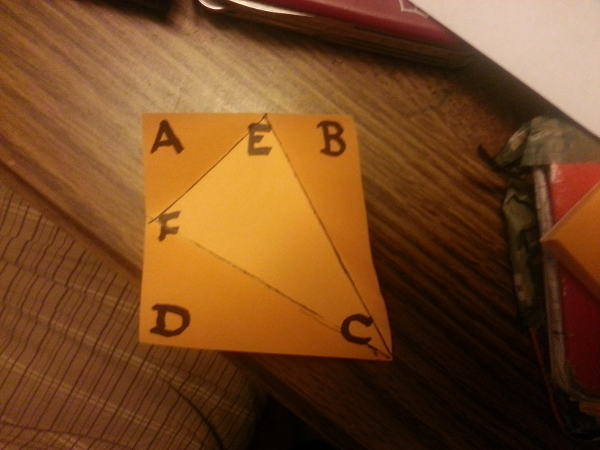When I find incorrect answers in Brilliant.org, which is way more often than it should be for only one month of activity, I try to report the problem.
Example:
Which of the following regular polygons can be folded into a pyramid without cutting or overlapping any area?
 The multiple choice approach of the problem is in error, because TWO of the regular shapes can each be folded into (non-flat) triangular pyramids.
The multiple choice approach of the problem is in error, because TWO of the regular shapes can each be folded into (non-flat) triangular pyramids.
TRIANGLE: Let its verteces be A, B, and C. Create Midpoints for AB, BC, and CA, called D, E, and F respectively. The triangular base is triangle DEF. This solution has the added bonus of creating a regular tetrahedron, but that was not a requirement.
SQUARE: Let its verteces be A, B, C, and D. Create Midpoints for AB and DA called E and F respectively. The triangular base is triangle ECF. Points A, B, and D meet above the base to form the pyramidal apex. It is an irregular tetrahedron of positive volume \(V = \frac{L \times W \times H}{3} = \frac{1}{3} \times\frac{1}{2} unit \times \frac{1}{2} unit \times 1 unit\ = \frac{1}{12}unit^3\) *, but is a valid solution. (Sides of the base measure \(EC=\frac{\sqrt{5}}{2}, CF=\frac{\sqrt{5}}{2}\) , and \(EF=\frac{\sqrt{2}}{2}\)). A square post-it note thus folded proves it to be true.
* CORRECTION: That would be the volume of a square base, but this base is triangular, so it has half that area. \(V = \frac{h \times A}{3} = \frac{1}{3} \times ( \frac{1}{2} \times \frac{1}{2} unit \times \frac{1}{2} unit ) \times 1 unit\ = \frac{1}{24}unit^3\)

Note: The problem on Brilliant.org has since been reworded so that it asks only for the polygon that can form a regular pyramid. But as we can see in my next post, that eliminates the irregular pyramids made by this square and with a regular pentagon, but doesn't necessarily exclude regular tetrahedrons made from any regular polygon leaving uncut, non-overlapping flaps.

